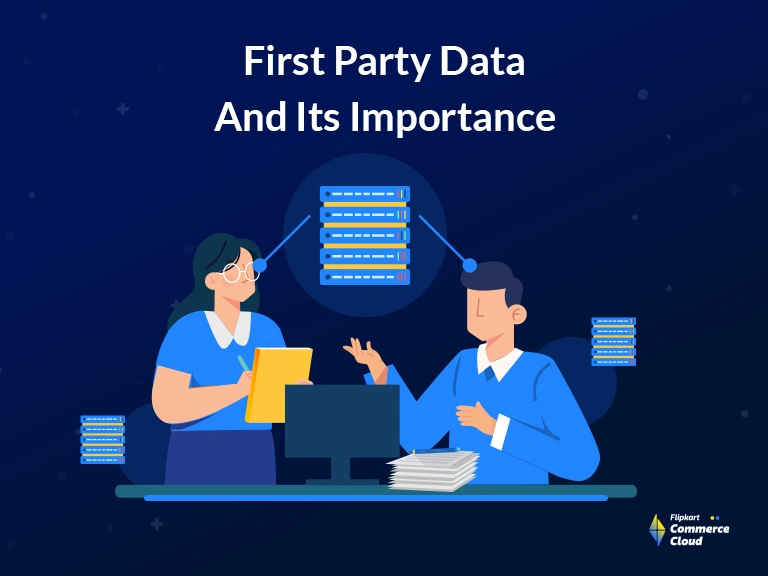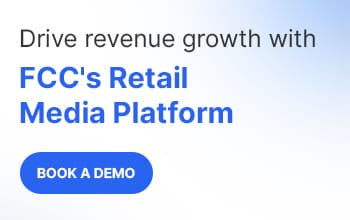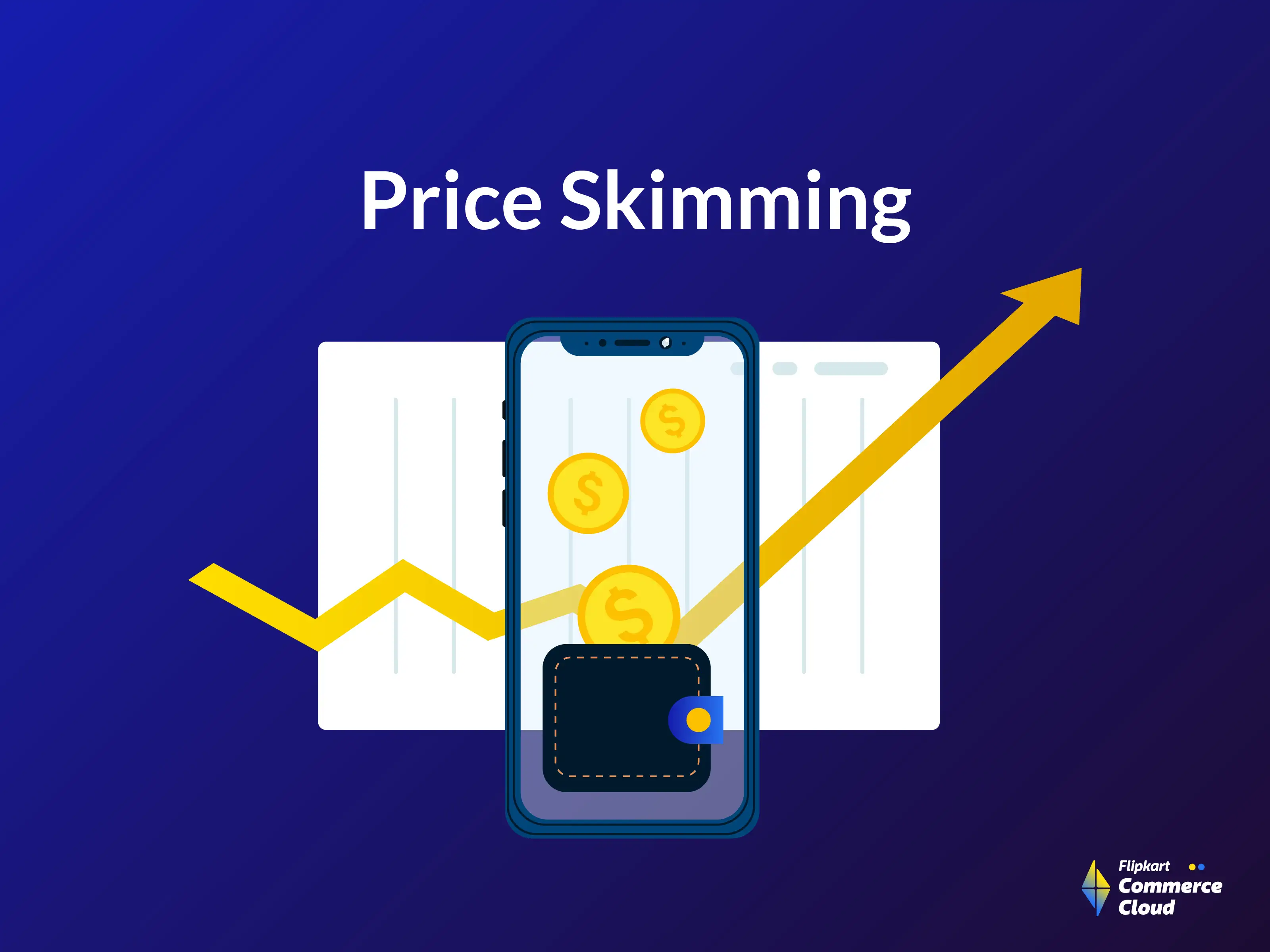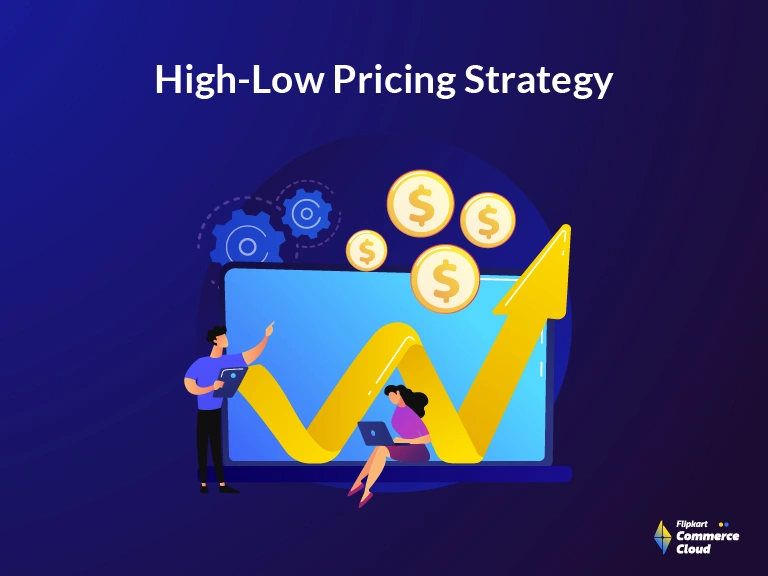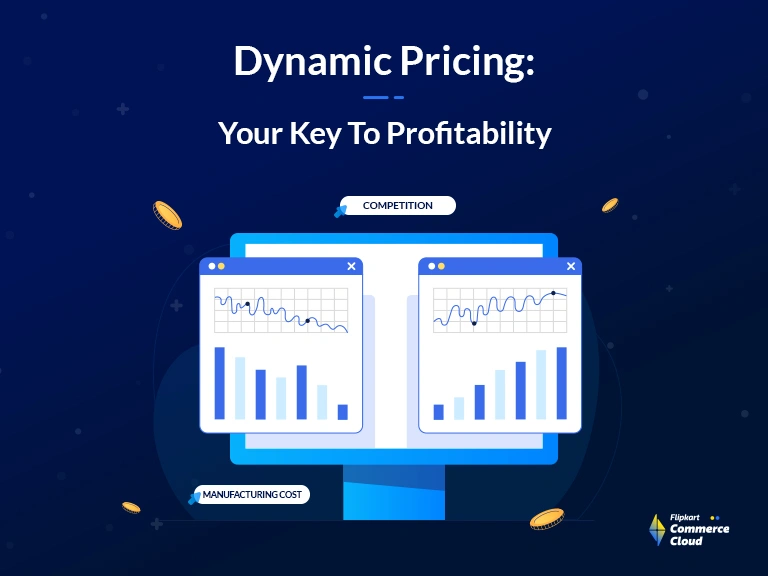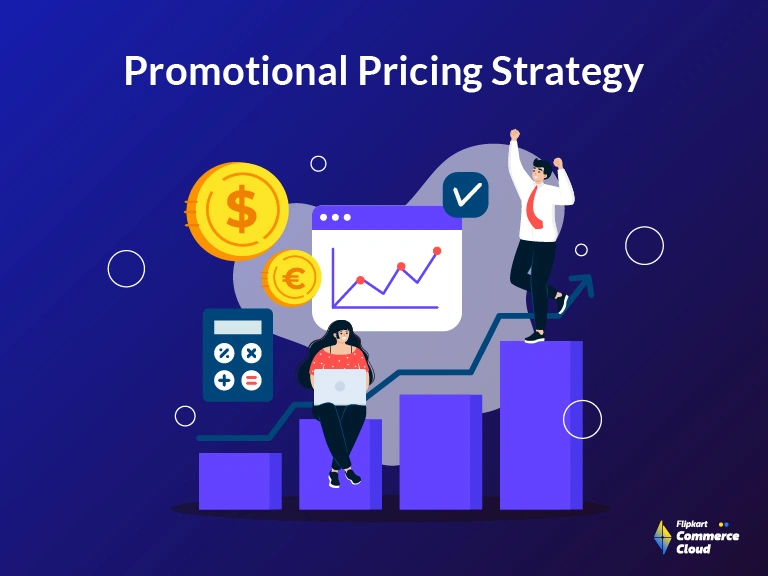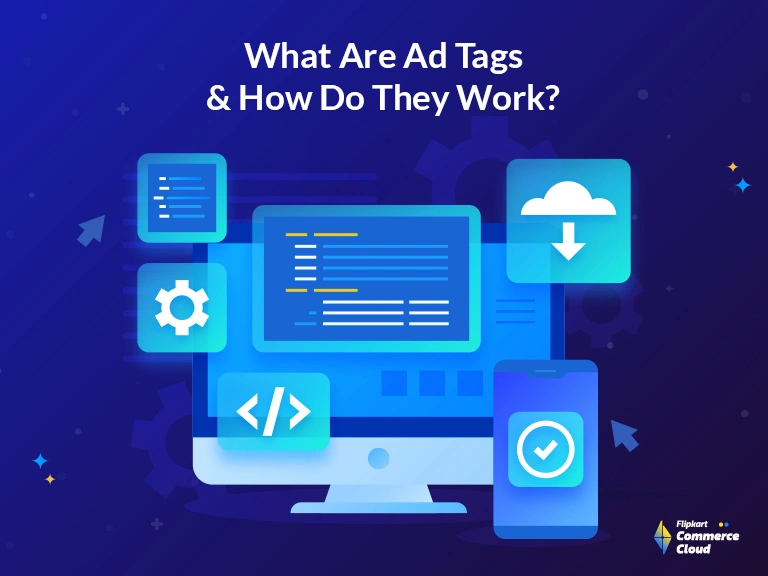The “cookie apocalypse” is causing major changes in the retail industry as strict data privacy regulations have made third party cookies obsolete. This has led to a shift towards first-party data, which retailers have access to but often fail to utilize due to inefficient collection and usage methods. Retailers are now realizing the potential of leveraging first-party data for insights, which not only improves individual revenue streams but also has a compounding effect on the business’s overall financial health.
First party data opens up new opportunities for monetizing supplier relationships, optimizing loyalty programs, and targeted retail media to increase traffic, sales, and investments from suppliers. In this blog post, we will delve into how retailers can take advantage of first-party data and highlight the need for cross-functional collaboration to fully seize its potential in a retail landscape that is moving beyond cookies.
Benefits of first-party data for retailers
With the rise of personalized customer experiences in the digital age, having access to first-party data is a must in retail. A study by Google and Boston Consulting Group (BCG) highlighted this importance, showing that brands that use first-party data strategies see up to 2.9 times more revenue growth and 1.5 times more cost savings.
First-party data is a valuable resource for understanding user behavior and preferences, as it is collected directly from customer interactions. With this data, retailers can develop precise customer profiles and highly targeted marketing strategies, resulting in more accurate and successful campaigns.
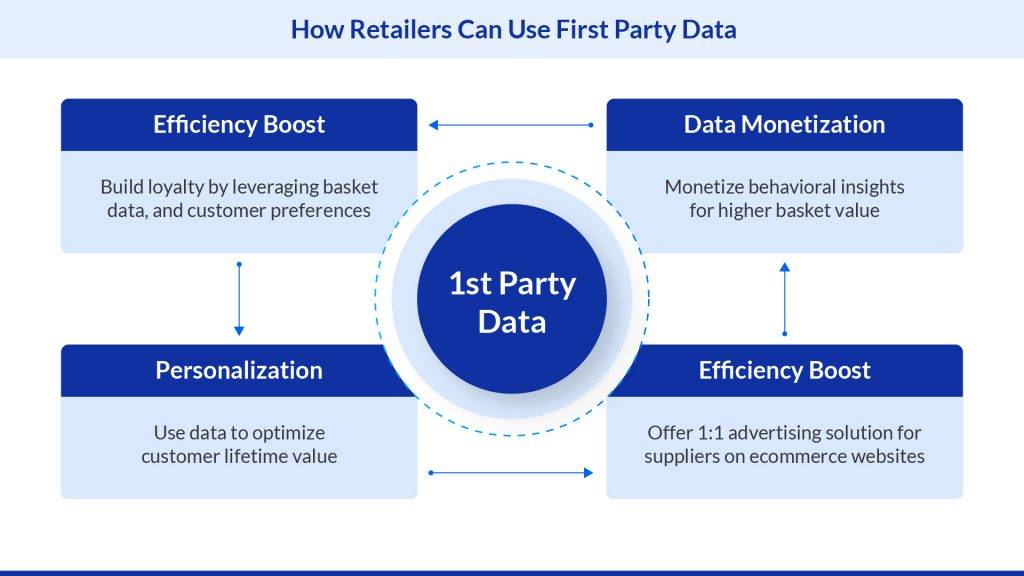
Retailers can tap into first-party data with these four key strategies:
- Developing sophisticated loyalty programs that enhance customer engagement and yield valuable data.
- Using this data to customize content, communication, and offers to provide customers with relevant and captivating experiences.
- Taking advantage of insights to offer targeted advertising opportunities, thereby creating new revenue streams.
- Transforming the wealth of data into actionable insights to create new opportunities for business growth.
This comprehensive approach generates a synergistic effect, where each strategy reinforces the others, resulting in a significant cumulative impact on both revenue and profit. For instance, personalized marketing strengthens loyalty programs, builds audience data and enables advanced targeting, leading to increased engagement, sales, and supplier investment.
Examples of retailers using first party data
Amazon, a dominant force in the retail media industry, has seen a rise in revenue from its advertising services by using its extensive first-party data to create targeted ad campaigns. Combining first party data examples (location data) with various sources, Amazon demonstrates the effectiveness of integrating different types of data to develop accurate shopper profiles and run successful advertising campaigns.
Meanwhile, major brick-and-mortar retailers like Costco, Target, and Walmart have observed higher foot traffic in their physical stores compared to online visits, indicating the continuing importance of physical retail spaces. They capitalize on this advantage by using their first-party data to reach specific shopper segments near their stores.
Similarly, Starbucks uses customer data from its mobile app and loyalty program to offer personalized rewards and promotions based on preferences, purchase history, and location. This strengthens customer loyalty and helps Starbucks refine its marketing tactics and product offerings to better align with consumer preferences.
But harnessing first-party data goes far beyond mere data gathering. It’s about creating a reciprocal relationship with customers, where they recognize the advantages of sharing their data. The exchange of valuable information with customers leads to more comprehensive data and gives retailers a competitive edge enabling better customer profiling, customized marketing efforts, and increased customer satisfaction. This makes first-party data a crucial element in the retail industry for achieving successful results.
How retailers can use first-party data
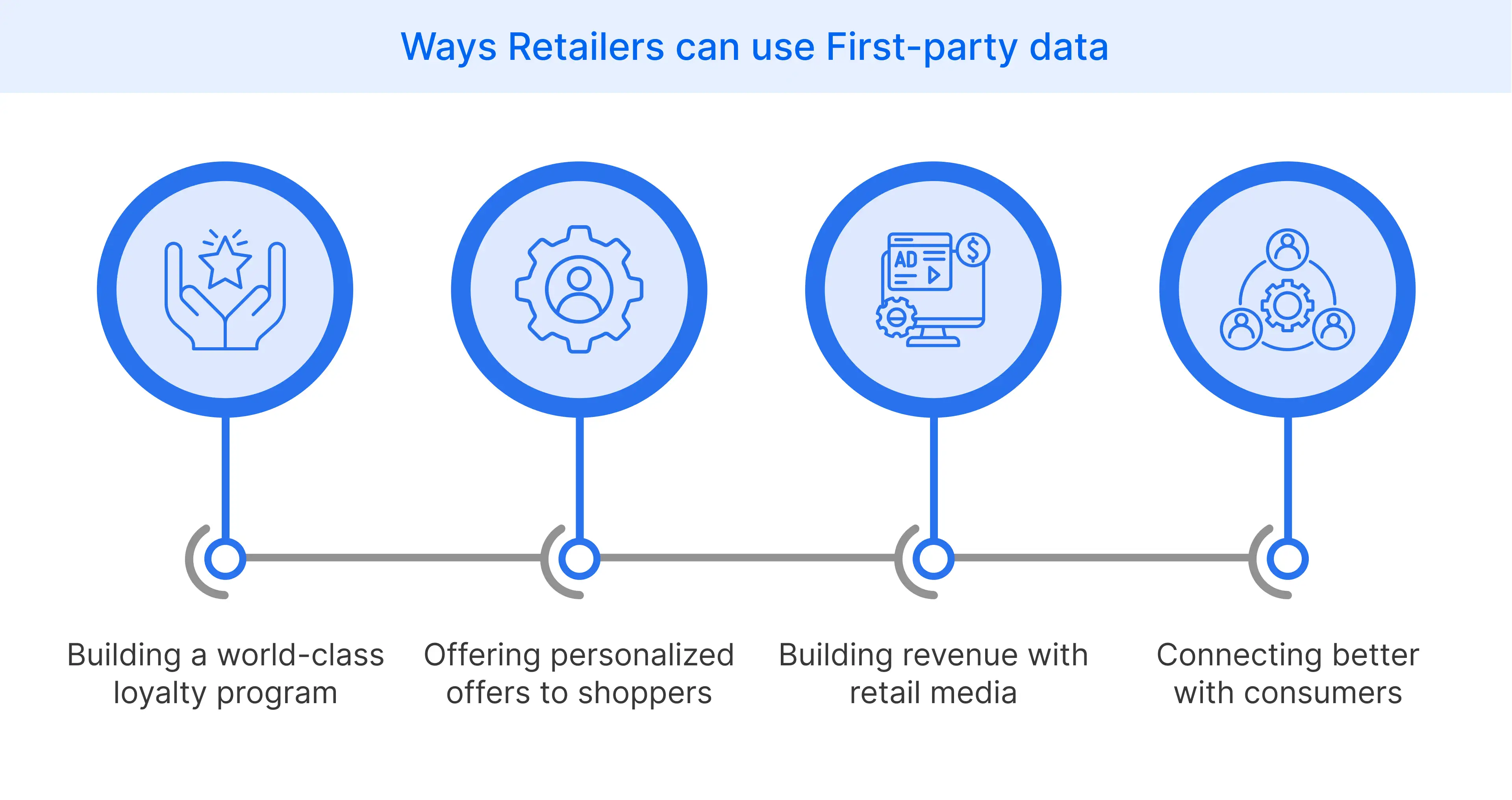
Use first-party data to build a world-class loyalty program
Retailers can leverage first-party data to create top-tier loyalty programs with highly personalized offers and recommendations by analyzing customer information such as previous purchases, preferences, and behavioral trends. This level of customization fosters deeper customer involvement and significantly enhances the perceived value of loyalty initiatives. Combining AI-driven insights enables cost-effective personalization, leading to more focused marketing efforts and better ROI on marketing spends.
Retailers should incorporate a multichannel approach to engage customers across various platforms to ensure a seamless and unified experience. Retailers can also use customer data to create unique opportunities like access to special events, and exclusive products, to meet the changing interests and desires of customers. Additionally, they can Introduce gamified elements, surprise offers, based on individual customer histories to elevate the appeal of loyalty programs.
Remember, these programs offer more than just basic rewards; they provide value-added experiences that go above and beyond. A tiered rewards system, based on thorough analysis of customer data, is a powerful tool for acknowledging and incentivizing top-tier customers. Retailers can use behavioral analysis to structure their programs effectively, incorporating insights from customer data to guide decisions about rewards, communication strategies, and product development. This data-driven approach ensures that every aspect of the loyalty program is finely tuned to meet the constantly evolving needs of customers and market trends.
In fact, PepsiCo increased its first party data collection by 50% through reward programs, QR codes, and targeted messaging.
There are numerous ways to obtain contact information from shoppers, such as requiring registration for webinars and gathering demographic data, interests, and preferences.
The key to a successful loyalty program is its ability to adapt and evolve. This means regularly analyzing program performance and using first-party data to make incremental improvements. Incorporating a feedback loop within the program for continuous refinement and personalization, can also help in enhancing the overall customer experience.
When building a loyalty program, be sure to have answers to these questions to ensure the program’s effectiveness and alignment with business objectives.
- What changes in customer behavior could significantly impact the business’s success?
- How can the program be designed to benefit both customers and the business equally?
- Should a standalone loyalty program be implemented, or is collaboration with a partner network more beneficial?
- What potential partners could add value to the program and align well with your brand?
- How can personalized programs be tailored to different custom segments effectively?
- In what ways can personalization lead to more precise and cost-efficient rewards, ensuring profitability for the program?
- How will you maintain ongoing customer interest and engagement at every interaction point?
- How can you make use of customized rewards, such as coupons, member discounts, and exclusive deals, to boost participation?
- How can you ensure the loyalty program delivers a distinctive customer experience that reflects your brand’s identity?
- What essential components do we need in our loyalty platform, i.e., managing loyalty, distributing offers, or hosting services?
- How can technology be used to simplify program management and improve customer experience?
- How will you protect customer data gathered through the loyalty program?
- How will you measure the success of the loyalty program?
Offer personalized offers to shoppers
The concept of first-party data has evolved beyond a simple marketing tactic for retailers. It has become a fundamental shift in how they engage with customers, emphasizing the importance of meeting customer needs and preferences over pushing products. At the core of this change is improving user experience on digital platforms. Retailers are optimizing their websites with the help of first-party data insights. This involves improving navigation, refining product recommendation engines, and streamlining the checkout process to make it easier for users to find and purchase what they want. Additionally, personalized marketing messages are crafted to deeply connect with the target audience, potentially leading to higher conversion rates. For instance, if data shows that a customer segment prefers sustainable products, marketing content is tailored to showcase these products, resulting in a more relevant and compelling experience for those shoppers.
Personalization has evolved from simply customizing products and services to catering to individual preferences. It now includes targeted advertising and promotions, utilizing the extensive targeting capabilities of ad platforms to reach specific consumers who are more likely to engage with their brand. This method allows retailers to make the most out of their marketing budget. Another popular strategy among retailers is personalized email campaigns based on customers’ purchase histories, which often suggest similar products or offer special deals on items that the customer has shown interest in previously..
The success of personalized retail relies on AI-powered personalization engines, which use advanced tools to analyze extensive data and provide customized product recommendations and opportunities for upselling and cross-selling. However, fully utilizing first-party data requires more than just technological expertise; it requires collaboration among marketing, analytics, technology, and category management teams. This collaborative approach ensures a comprehensive and unified strategy for personalization, creating a culture where customer needs and preferences guide decision-making.
Answer these questions to enhance your personalization efforts:
- What do you hope to achieve through personalization, and how does it support your broader business objectives?
- Which Key Performance Indicators (KPIs) will provide an effective measure of the success of your personalization efforts?
- Where should you focus your initial personalization efforts within your loyalty program?
- What are some simple yet effective ways to personalize customer experience to achieve company goals ?
- How well do these approaches match the preferences and behaviors of your chosen customer segment?
- What specific loyalty data can you use to power these personalized experiences, and how reliable is this data?
- What tools and measures will help you track shifts in customer engagement and purchasing behavior?
- How will you ensure ongoing monitoring, analysis, and refinement of your personalization strategies?
Build revenue with retail media
Now more than ever, companies must prioritize expanding the use of first-party data in all customer interactions and generate new revenue streams. One effective approach to achieving these goals is to consider launching a retail media network to gain deeper insights into customers and provide more personalized experiences. According to Forbes, Amazon generated $31.1 billion in ad sales on its platform in 2021, while Walmart revealed that it made $2.1 billion from ads in 2020.
At its core, retail media revolves around retailers offering advertising space and data to other businesses, such as consumer product suppliers. These ads are strategically placed using the retailer’s own data across various channels including their websites, and mobile apps.
Retail media has been experiencing a significant increase in popularity recently. McKinsey predicts strong growth in advertising spending, projecting an increase from around $45 billion to over $100 billion by 2026. This growth is being driven by advertisers, with 74% of brands reported to have a separate retail media budget, marking a threefold rise from 2021.
To tap into the full potential of retail media, retailers need to build a diverse range of media products with a dedicated team focused on creating and selling these offerings. This approach improves outreach, audience involvement, data accuracy, and cost-effectiveness of the media spend (CPM). At FCC we can help you build a robust retail media platform, book a demo today to learn more about how we can help.
Answer these questions to solidify your retail media approach for increased revenue:
- What is the target size and scope of your retail media business?
- Who are your initial target clients, and which product categories are you focusing on for retail media campaigns?
- Which channels have the best potential for success?
- Can you offer value-added services like analytics or creative content?
- What first-party data is available, and how can you access and utilize it? Do you need to integrate additional external data sources?
- What is the depth of your first-party data, and how accessible is it for retail media?
- Are there gaps in your data, and what external data sources should you integrate for a more comprehensive approach?
- How do you plan to handle any conflicts of interest between retail media and other business units?
- What roles are critical to your retail media team, and do you have the appropriate talent?
- How will you ensure successful coordination between the retail media team and other teams?
- What are the most important steps in your strategy for building the retail media business?
- How will you evaluate success and modify your strategy over time?
Connect better with consumers using first-party data
It’s clear by now that first-party data allows retailers to personalize their messaging and reach customers at various stages of their journey. This process also includes using offline customer information for digital targeting and tailoring ads to specific devices.
In fact, retailers are now using advanced modeling techniques such as predictive analytics to better understand customer behavior. One such technique, called look-alike modeling, is especially useful in identifying and reaching out to potential customers who share similar traits with their most valuable existing ones. By focusing on these “look-alikes,” businesses can better allocate their marketing efforts, targeting individuals who are more likely to be interested in their products or services. This approach results in improved efficiency and effectiveness of marketing campaigns, leading to higher conversion rates, greater customer acquisition, and ultimately increased revenue and profitability for the company.
Website analytics, customer feedback forms, social media monitoring, loyalty programs and transactional data analysis are all useful tools in gaining a deeper understanding of user behavior and preferences. Retailers can also conduct targeted customer research through surveys to gather valuable insights from specific audience groups. Using first-party data, such as product tests with loyal customers and strategic product launches, can lead to successful outcomes for retailers both in-store and online.
Apart from these methods, another effective tactic retailers can use is audience suppression. With this approach certain segments are excluded from marketing campaigns, such as recent in-store purchasers or high-risk prospects. This helps streamline marketing efforts and make them more effective.
How FCC can help boost your business
Flipkart Commerce Cloud (FCC) is a comprehensive solution for modern retail challenges in today’s data-driven world. With proven success and global implementation, FCC’s solutions are tailored to diverse markets, allowing businesses to stay ahead in the highly competitive retail landscape.
FCC offers end-to-end retail media tools that help businesses unlock the full potential of the retail ecosystem. We offer:
Marketplace technology stack: With over 40 plug-and-play components, our comprehensive suite offers everything from personalized experiences to inventory tracking and warehousing technology. The platform helps retailers efficiently scale their online operations, improve customer satisfaction, and drive online and offline sales growth.
Retail media solution: FCC’s Retail Media Solution offers AI-driven advertising to maximize your impact. This advanced ads engine understands the entire shopper’s journey and intent, leveraging sophisticated AI/ML algorithms. With its deep audience understanding and real-time adaptability, it places highly relevant and personalized ads for maximum impact. Plus, data privacy is never compromised, ensuring ads resonate with consumers’ interests and behaviors. Continuous performance measurement and insights help optimize outcomes for your business.
Retail pricing manager: FCC’s Pricing Manager is a cloud-based solution that automates and optimizes pricing decisions for retailers. It utilizes dynamic pricing and competitive intelligence powered by machine learning models that analyze historical sales data to understand price elasticity. With game theory, it can predict customer responses to price changes, allowing retailers to set optimal pricing strategies.
Eager to learn more about how FCC’s retail solutions can help boost your business? Contact our experts today!
